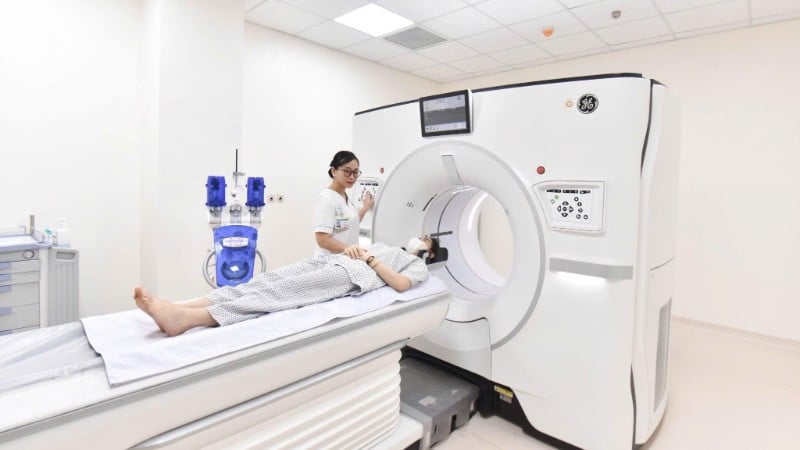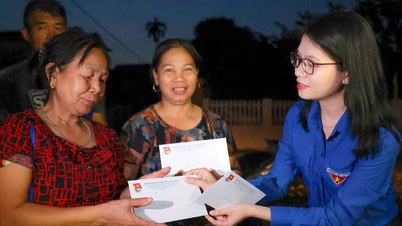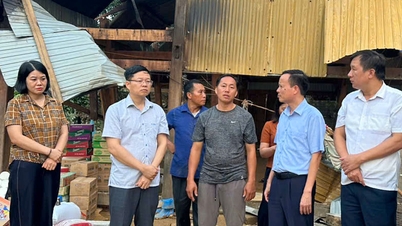
There are many challenges
According to Colonel Tran Duy Hung, Deputy Director of the Military Medical Department, the military hospital system currently has 12 grade I hospitals and 13 grade II hospitals, most of which are classified as providing basic medical examination and treatment.
In 2020, Military Hospital 103 (Military Medical Academy) successfully transplanted both the heart and kidney of a 40-year-old male patient with end-stage heart failure and chronic kidney failure. This is considered a major scientific milestone, affirming that the organ transplant level of Vietnam Military Medicine is on par with major centers in the region.
Over the years, Military Hospital 175 has organized many working groups to take turns working at Truong Sa Infirmary, providing health care for soldiers and people on the island district, DK1 platform and the southern sea and island areas. Veteran and war invalid Hoang An, Ban Co Ward, Ho Chi Minh City said: Coming to Military Hospital 175, we feel like we are back with our comrades, being examined and treated by doctors and nurses with all our heart, in the spirit of Uncle Ho's soldiers.
However, the organizational system of military hospitals still faces many difficulties when the number of departments and divisions at different levels is not suitable. The final level hospitals of military regions have 26-37 departments and divisions, while the regional hospitals of military regions only have 14-27 departments and divisions.
Many places lack some important departments such as Nutrition, Quality Management, Information Technology. Many departments have to combine different majors, going against the trend of increasingly specialized development of modern medicine.
Many hospitals have to establish a number of temporary departments, divisions, and units such as the Department of Obstetrics and Gynecology, the Department of Infection Control, the Information Technology Team, and the Health Insurance Team.
In addition, the ratio of professional staff to the total number of staff in 25 hospitals is currently only 75.77%, lower than the regulation of the Ministry of Health from 80-82%. In terms of professional qualifications, the number of highly qualified experts is not much, most of them are university, college, intermediate and primary level.
In the period 2014-2024, many hospitals invested for less than 10 years have quite modern facilities, interconnected and synchronized with equipment, meeting national standards on hospital construction. However, some hospitals invested for more than 20 years have expired, lacking synchronization with newly invested modern equipment. The interconnectivity between buildings and departments is not high, the functional chain is not suitable, not meeting the technical criteria for hospital construction according to national standards (TCVN 4470:2012).
In the period of 2022-2024 and the first 6 months of 2025, military hospitals examined nearly 9.5 million patients, of which 8.54% were soldiers and 31% were group A (priority group), the number of patients admitted reached more than 1 million people; the bed utilization rate reached 117.68%; nearly 300,000 surgeries were performed, of which more than 131,000 were type I and special cases.
Regarding infrastructure and medical equipment, 24/25 hospitals have a CT scan system with 32 rows, 14/25 hospitals have a system with 64 to 128 rows, 12/25 hospitals have a 1.5 Tesla MRI system and 12/25 hospitals have continuous blood filtration machines, but the quality is uneven, many devices have degraded.
In particular, field medical equipment serving military and defense missions has mostly been invested in for over 10 years, is nearly depreciated or fully depreciated, and needs to be upgraded or replaced.
Although all military hospitals are moving towards “smart hospitals”, most of them have deployed hospital management information systems and laboratory information systems, but the level of application is not high. The image archiving and communication system (RIS-PACS) is still limited, only 5/25 hospitals have reached the advanced level, many hospitals have only reached the basic level or are just running the test.
Since 2018, military hospitals have been financially autonomous according to Directive No. 85/CT-BQP. Currently, there is 1 autonomous hospital in group 1, 6 hospitals in group 2 and 18 hospitals in group 3.
In the period of 2022-2024 and the first 6 months of 2025, military hospitals examined nearly 9.5 million patients, of which 8.54% were soldiers and 31% were group A (priority group), the number of patients admitted reached more than 1 million people; the bed utilization rate reached 117.68%; nearly 300,000 surgeries were performed, of which more than 131,000 were type I and special cases.
Goals and strategic solutions
Major General, Professor, Doctor Nguyen Truong Giang, Director of the Military Medical Department, said: The Military Medical Sector aims to develop a high-quality human resource team, develop specialties evenly, have key specialties, ensure in-depth expertise for general department-level hospitals and approach in-depth expertise for military region, army corps, and military branch hospitals; focus on investing in modern, advanced equipment, synchronized with infrastructure, suitable for technical expertise decentralization, fully meeting the norms and needs of medical examination and treatment in peacetime, military-defense tasks and readiness to serve in wartime.
Regarding organization and staffing, a streamlined, modern structure will be built, with all departments in accordance with the provisions of the Law on Medical Examination and Treatment, meeting all requirements from routine medical examination and treatment to ensuring combat readiness and performing military and defense tasks.
Major General, PhD, People's Physician Tran Quoc Viet, Party Committee Secretary, Director of Military Hospital 175 emphasized: It is necessary to strengthen training, improve practical capacity, training in the form of hand-on training, training at the location and training in technical teams; organize rotations, mobilize cadres and employees to central hospitals, leading specialized hospitals to update new treatment methods, high technology, manage complicated cases and transfer techniques; diversify types of training at home and abroad, short-term and long-term, focus on participating in international training programs and exercises to improve the capacity to respond to medical emergencies, natural disasters and epidemics.
In the period 2025-2030, it is expected to synthesize the need to upgrade the infrastructure of 25 hospitals, including renovation, repair and new construction. The Military Medical Sector will prioritize investment in essential and specialized equipment for all stages, from diagnosis, treatment to surgery, field emergency, meeting the need to improve the quality of medical examination and treatment, serving the goal of health care for soldiers and people. Improve the effectiveness of financial autonomy to ensure budget sources for training, repair, maintenance of equipment, scientific research and transfer of technical expertise; Implement the Sea and Island Health Program, invest in human resources, infrastructure, and medical equipment to ensure adequate capacity for emergency care, medical examination, treatment, and transportation for soldiers and people in sea and island areas, contributing to the implementation of the goals of the Sea and Island Health Development Program until 2030 according to Decision No. 658/QD-TTg dated June 8, 2023 of the Prime Minister.
Source: https://nhandan.vn/nganh-quan-y-tang-chat-luong-kham-chua-benh-post913953.html



![[Photo] General Secretary To Lam visits Kieng Sang Kindergarten and the classroom named after Uncle Ho](https://vphoto.vietnam.vn/thumb/1200x675/vietnam/resource/IMAGE/2025/10/09/1760023999336_vna-potal-tong-bi-thu-to-lam-tham-truong-mau-giao-kieng-sang-va-lop-hoc-mang-ten-bac-ho-8328675-277-jpg.webp)

![[Photo] Prime Minister Pham Minh Chinh chairs a meeting of the Government Standing Committee on overcoming the consequences of natural disasters after storm No. 11](https://vphoto.vietnam.vn/thumb/1200x675/vietnam/resource/IMAGE/2025/10/09/1759997894015_dsc-0591-jpg.webp)

![[Photo] President Luong Cuong attends the 80th Anniversary of the Traditional Day of Vietnamese Lawyers](https://vphoto.vietnam.vn/thumb/1200x675/vietnam/resource/IMAGE/2025/10/09/1760026998213_ndo_br_1-jpg.webp)



















































































Comment (0)